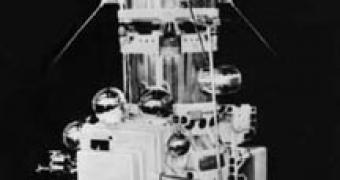More than 42 years ago, the Soviet Union launched what is now known as the first human-built spacecraft to enter the orbit of another celestial body except Earth. Luna 10 liftoff from the Baikonur Cosmodrome launchpad - today in Kazakhstan - on 31 March 1966, and on 3 April 1966 at 18:44 UTC it entered in orbit around the Moon.
The rocket carrying the orbiter was a four-stage Molniya 8K78M. Luna 10 along with the Molniya rocket measured 2.7 meters long, 1 meter in diameter and weighed 245 kilograms with an empty tank. When loaded with fuel, it reached a weight of 1,600 kilograms. After being carried into space, Luna 10 was put into a trajectory pointing towards the Moon, when the two vehicles separated from one another. The next day, the Luna 10 orbiter made correction maneuvers to its trajectory.
On 3 April, Luna 10 arrived to the Moon and inserted itself into a orbit 350 by 1,017 kilometers, with an eccentricity of 71.9 degrees. A couple of minutes later, the orbiter separated from the flight vehicle that delivered it to the Moon and began probing the surface of the Moon. Luna 10 was capable of making a complete rotation around the Moon once every 178.05 minutes, and is known to have completed 360 orbits during its two months study.
During its mission, Luna 10 studied the Moon's magnetic field, the amount of gamma ray light reflected from the surface and conducted a series of other measurements involving instruments such as gas-discharge counters, meteorite detectors, infrared sensors, x-ray photon counters and a solar-plasma instrument.
It was powered with the help of batteries which allowed it to send back to Earth more than 219 radio transmissions to be analyzed by Soviet researchers. After exactly 60 days since it was launched, Luna 10 altered its orbit to 378 by 985 kilometers and an eccentricity of 72 degrees, when Soviet engineers lost contact with it.
It is unknown what really happed with the spacecraft after the radio contact was lost, however most researchers believe it had crashed onto the surface of the Moon soon after the incident.

 14 DAY TRIAL //
14 DAY TRIAL //